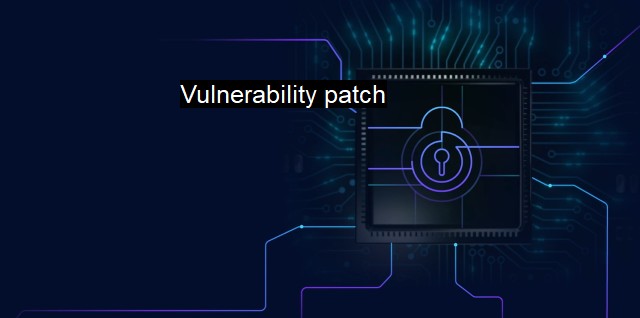What is Vulnerability patch?
Strengthening the Cybersecurity Posture: The Critical Role of Vulnerability Patching
In the realm of cybersecurity and antivirus strategies, the utilization of a 'Vulnerability Patch' is an indispensable tool that aids in global efforts to maintain robust, secure, and productive digital environments. The term essentially relates to the repairing, or "patching," of vulnerabilities discovered in software or firmware with the aim of securing the systems in question.To fully comprehend what a vulnerability patch is, one needs to be acquainted with the concepts of vulnerabilities and patches in the world of cybersecurity. A vulnerability in software or a system is essentially a flaw in the code, a loophole that can be taken advantage of by hackers to gain unauthorized access to the system, it can be an oversights that enables infiltration or exploitation of a system. Such flaws can occur due to a variety of reasons including, but not limited to, design limitations, programming errors, incorrect network configurations, etc.
Patches, on the other hand, are pieces of software designed to update a computer program or data, meant to install updates, fix bugs, or enhance performance. In the context of vulnerabilities, these patches are the corrective measures that help in combating a specific weakness affecting a program or a networked system by enhancing security and mitigating risks or potential harm.
A vulnerability patch can be understood as the junction of these two crucial cybersecurity elements: identifying system vulnerabilities and implementing measures to fixing them. The term refers to a specific fix applied to a vulnerability in a software program or a system with the intent of crushing the loophole exploited by attackers. The primary objective of such patching is to establish a safeguarded tech environment by bolstering overall software and system immunity against cyber threats.
Underlining the importance of vulnerability patches, most software manufacturers release regular patches to protect their consumers. Such updates often include these security patches aiming to address newly discovered vulnerabilities in the respective software. They end up mending several issues from simple functional bugs, to serious security vulnerabilities, that have the potential to jeopardize the entire system.
The process is not as straightforward as it may seem. The deployment of a vulnerability patch is preceded by the tedious task of vulnerability management which encompasses the identification, classification, and prioritization of vulnerabilities in networked systems. Once identified, these defects need to be addressed in descending order of their severity. Then comes the patching process, an equally intricate task demanding caution to ensure that the applied patch doesn't disrupt the overall functioning of the system.
What makes vulnerability patches even more integral is their role in antivirus strategies. Modern Antivirus solutions iterate on threat detection strategies, including both signature-based and behavioral-based detection. They typically scan systems for known vulnerabilities that could serve as potential exploitation points for malicious software. In concurrent with detection mechanisms, these Antivirus solutions sometimes also act as patchers by providing automatic updates, thereby ensuring an everyday user doesn’t lack behind in system protection.
In today's ever-evolving cyberspace, the basic yet crucial tool of vulnerability patch is unavoidable. Neglecting or delaying patching can catalyze an easy gateway into a computer or network, regardless of having the most advanced security measures in place. a vulnerability patch acts as the armor designed directly to counter known threats and is an indispensable gear in the robust framework of cybersecurity and antivirus landscape. Yet beyond patching, one must also remember that it’s part of a larger effort, with companies and individuals need to cultivate a culture of thorough cybersecurity hygiene, prioritizing regular updates and safe data practices to thwart malicious intents from infecting our digital spaces.

Vulnerability patch FAQs
What is a vulnerability patch?
A vulnerability patch is a software update that fixes a security flaw in a program or system, with the aim of preventing malicious attacks and ensuring the security of the system.Why is it important to install vulnerability patches?
Installing vulnerability patches is crucial for protecting your computer or network from cyber threats. Hackers often exploit vulnerabilities in software to gain unauthorized access, steal data or install malware, and installing patches helps to eliminate these security holes.How often should I install vulnerability patches?
It is recommended to install vulnerability patches as soon as they become available, as they provide immediate protection against known security threats. Many software programs have automatic updates that install patches automatically, but it is also important to periodically check for updates manually.Can vulnerability patches cause problems with existing software?
Occasionally, vulnerability patches may affect the way certain programs work or cause compatibility issues, especially if you are using an older version of the software. However, it is important to install patches, as the risks of leaving a vulnerability exposed far outweigh any potential issues that might arise from installing the patch. In some cases, vendors release additional patches to address compatibility issues.| | A | | | B | | | C | | | D | | | E | | | F | | | G | | | H | | | I | | | J | | | K | | | L | | | M | |
| | N | | | O | | | P | | | Q | | | R | | | S | | | T | | | U | | | V | | | W | | | X | | | Y | | | Z | |
| | 1 | | | 2 | | | 3 | | | 4 | | | 7 | | | 8 | | |||||||